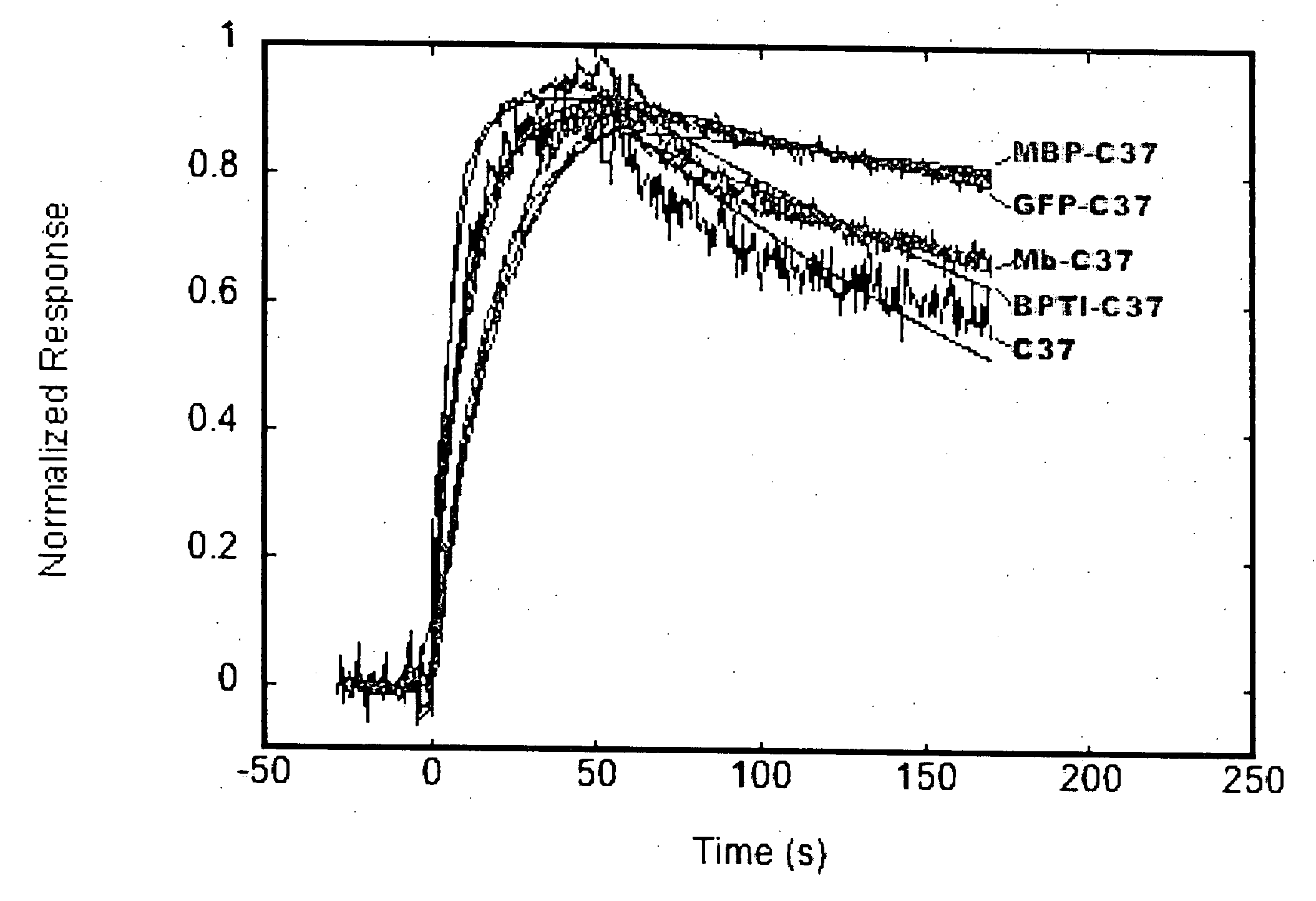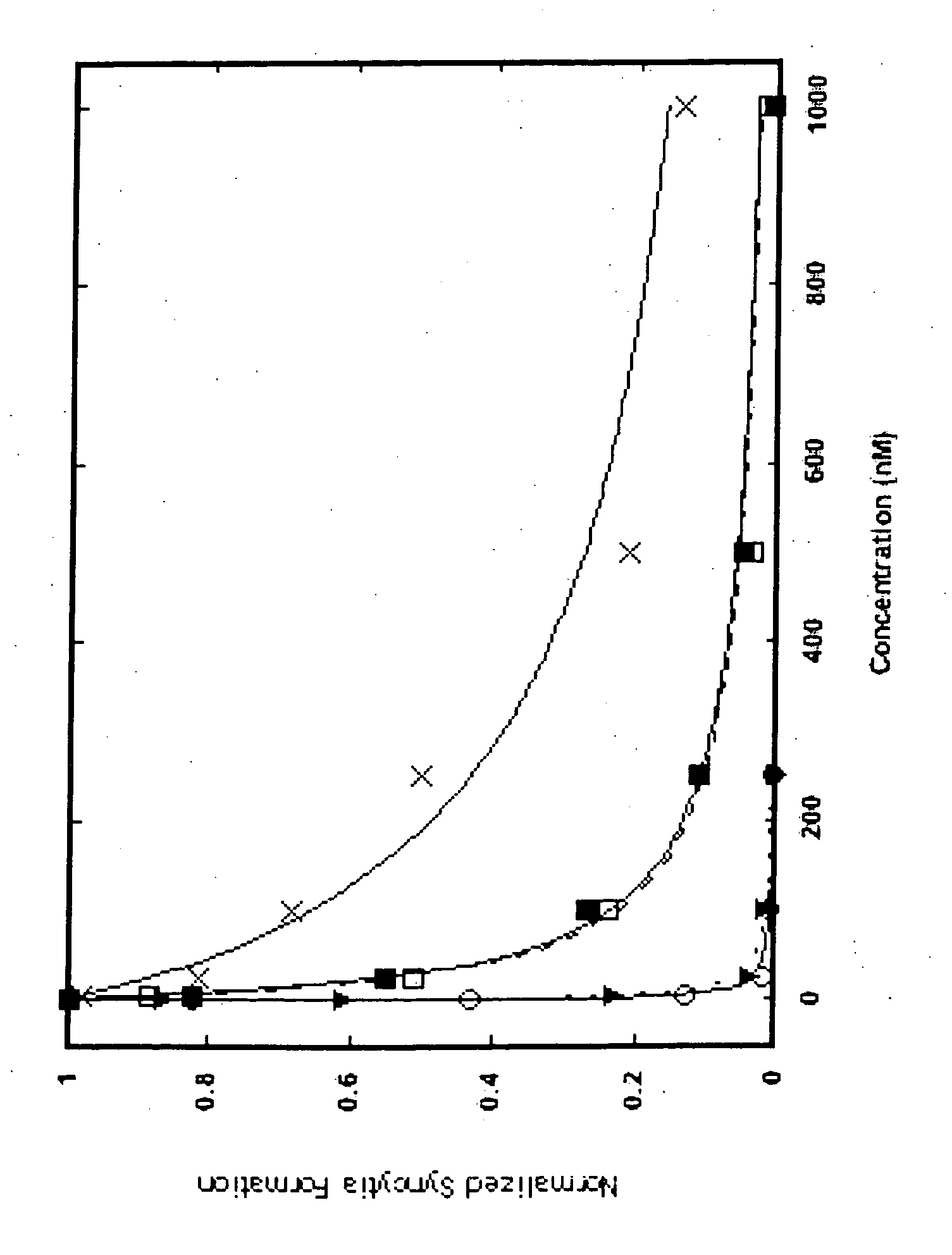Designed antigens to elicit neutralizing antibodies against sterically restricted antigen and method of using same
a technology of neutralizing antibodies and antigens, applied in the field of biotechnology, can solve the problems of virus resistance to these small molecules, intolerant to the available drugs, and immediate adverse effects, and achieve the effect of preventing the function of molecules
- Summary
- Abstract
- Description
- Claims
- Application Information
AI Technical Summary
Benefits of technology
Problems solved by technology
Method used
Image
Examples
example 1
Protein Expression, Purification, and Characterization of IZN36 and Sterically Restricted C37
[0090] To test for steric constraints in accessing the gp41 N-trimer region a series of inhibitors containing a C-peptide attached to cargo proteins of various sizes were created. The cargo partners used were selected for the following properties: monomeric, soluble, globular, stable, tolerant to C-terminal additions, and free of non-specific peptide binding. Cargo proteins meeting these inclusion criteria and used to illustrate the invention range from 6 to 41 kDa (Table I). C37, the recombinant His-tagged version of the previously characterized synthetic peptide C34, was used as the reference inhibitor. In each fusion protein, C37 is connected at its N terminus to the C terminus of the cargo by a flexible 6- or 7-residue Ser / Gly linker. This linker was designed to be long enough to allow the proper orientation of C37 as it binds to the N-trimer but short enough for the attached cargo to p...
example 2
Surface Plasmon Resonance (SPR) Analysis of Sterically Restricted C37
[0095] Binding experiments were performed using a Biacore 2000 optical biosensor (University of Utah Protein Interaction Core Facility) equipped with research-grade CM5 sensor chips (Biacore). A standard coupling protocol was employed to immobilize streptavidin (SA; Pierce). Biotinylated IZN36 was captured on a SA surface, and free SA surfaces served as references.
[0096] Binding analysis of C37 and C37 fusion proteins was performed at 25° C. with a data collection rate of 2.5 Hz. The binding buffer (phosphate-buffered saline) +0.005% P20 detergent (Biacore)+1 mg / ml bovine serum albumin (fraction V; Fisher)) was prepared, vacuum filtered, and degassed immediately prior to use. Stock solutions of C37, C37 fusion proteins, and corresponding control proteins (without C37) were prepared in binding buffer at 100 nM. Protein binding was analyzed by injecting samples for 1 min over the IZN36 and reference surfaces using ...
example 3
Effects on Cell-Cell Fusion and Viral Infectivity Assay for Sterically Restricted C37
[0100] Cell-cell fusion was monitored. HXB2 Env-expressing Chinese hamster ovary cells were mixed with HeLa-CD4-LTR-β-galactosidase cells in the presence of inhibitors for 20 h at 37° C. Syncytia were stained with 5-bromo-4-chloro-3-indolyl-β-D-galactopyranoside (X-gal) and counted.
[0101] Viral infectivity was measured by the following method: pseudotyped viruses were produced by co-transfecting 293T cells using FuGENE (Roche Applied Science) with pNL4-3.Luc.R-E- and either pEBB-HXB2 or pEBB-JRFL. After 36-48 h, viral supernatants were collected and sterile filtered. HXB2 or JRFL pseudotyped virus was added to HOS-CD4-fusin or HOS-CD4-CCR5 cells, respectively, in the presence of inhibitors. HXB2 assays included 20 μg / ml DEAE-dextran. After 12 h, virus and inhibitor were removed and replaced with fresh media. Cells were lysed 40-44 h after infection using Glo lysis buffer (Promega), and luciferase ...
PUM
| Property | Measurement | Unit |
|---|---|---|
| size | aaaaa | aaaaa |
| size | aaaaa | aaaaa |
| diameter | aaaaa | aaaaa |
Abstract
Description
Claims
Application Information
 Login to View More
Login to View More - R&D
- Intellectual Property
- Life Sciences
- Materials
- Tech Scout
- Unparalleled Data Quality
- Higher Quality Content
- 60% Fewer Hallucinations
Browse by: Latest US Patents, China's latest patents, Technical Efficacy Thesaurus, Application Domain, Technology Topic, Popular Technical Reports.
© 2025 PatSnap. All rights reserved.Legal|Privacy policy|Modern Slavery Act Transparency Statement|Sitemap|About US| Contact US: help@patsnap.com



